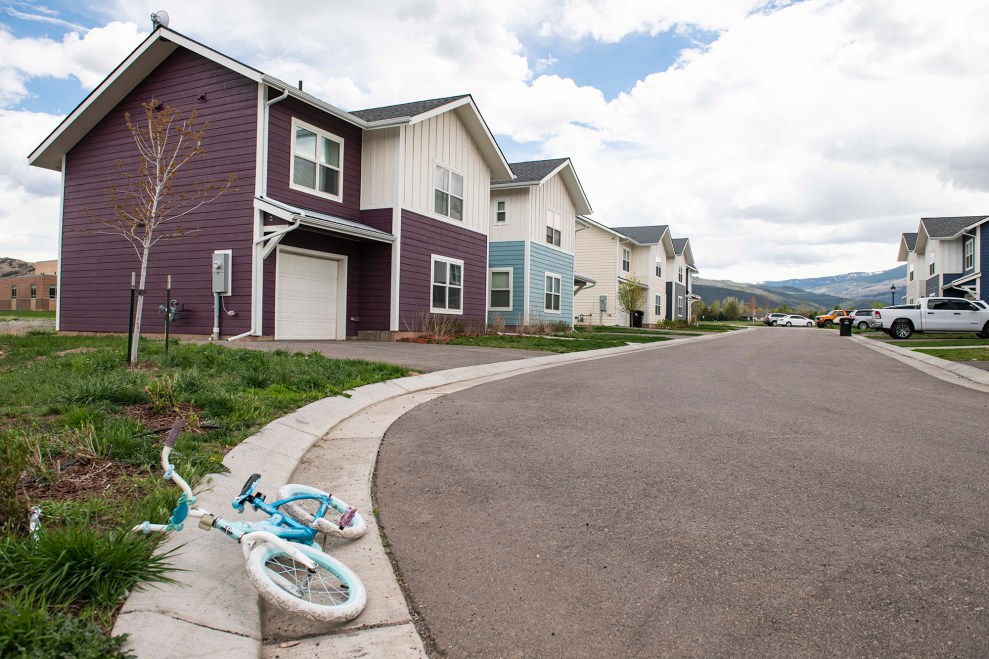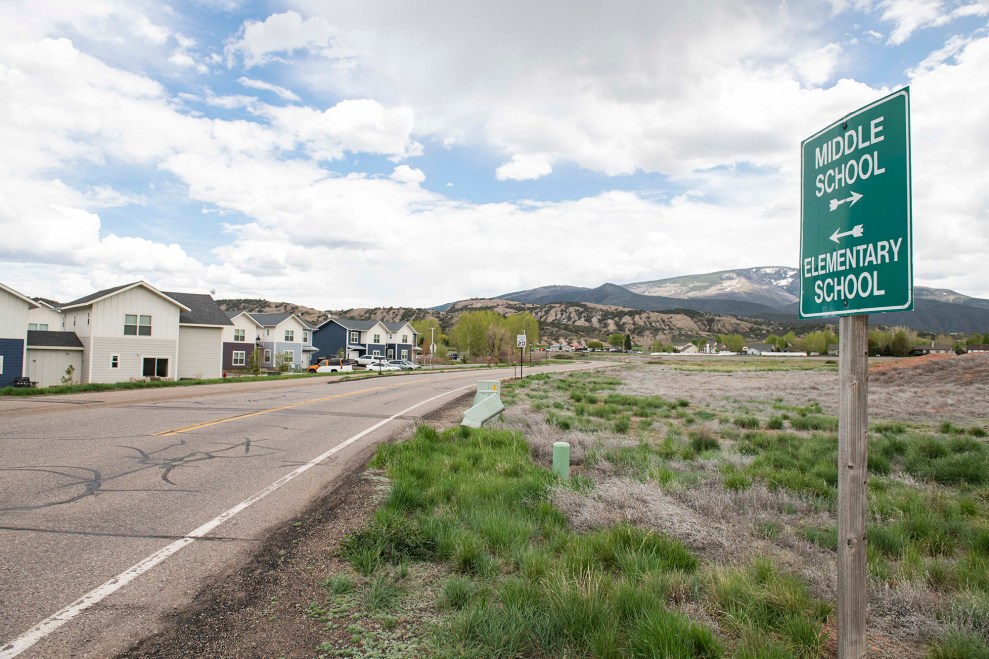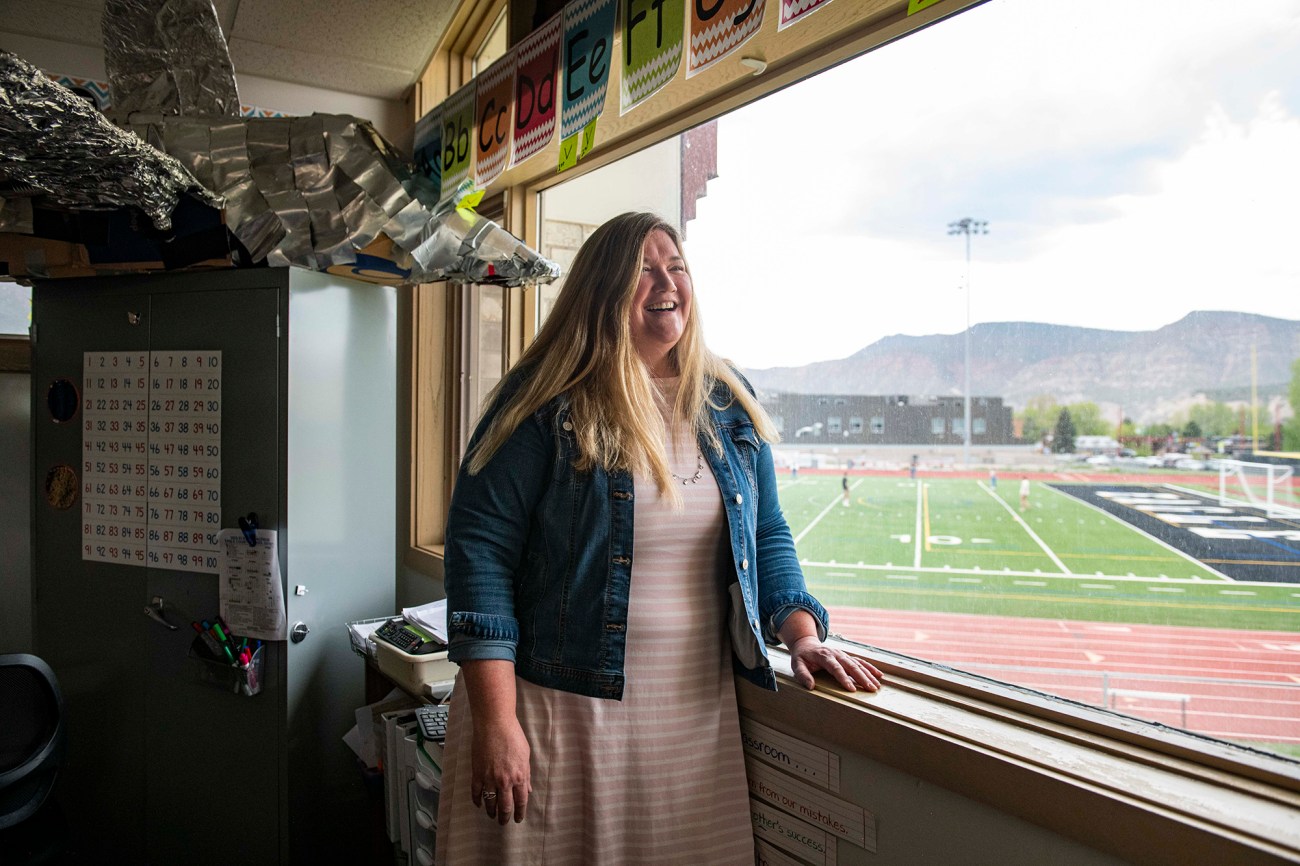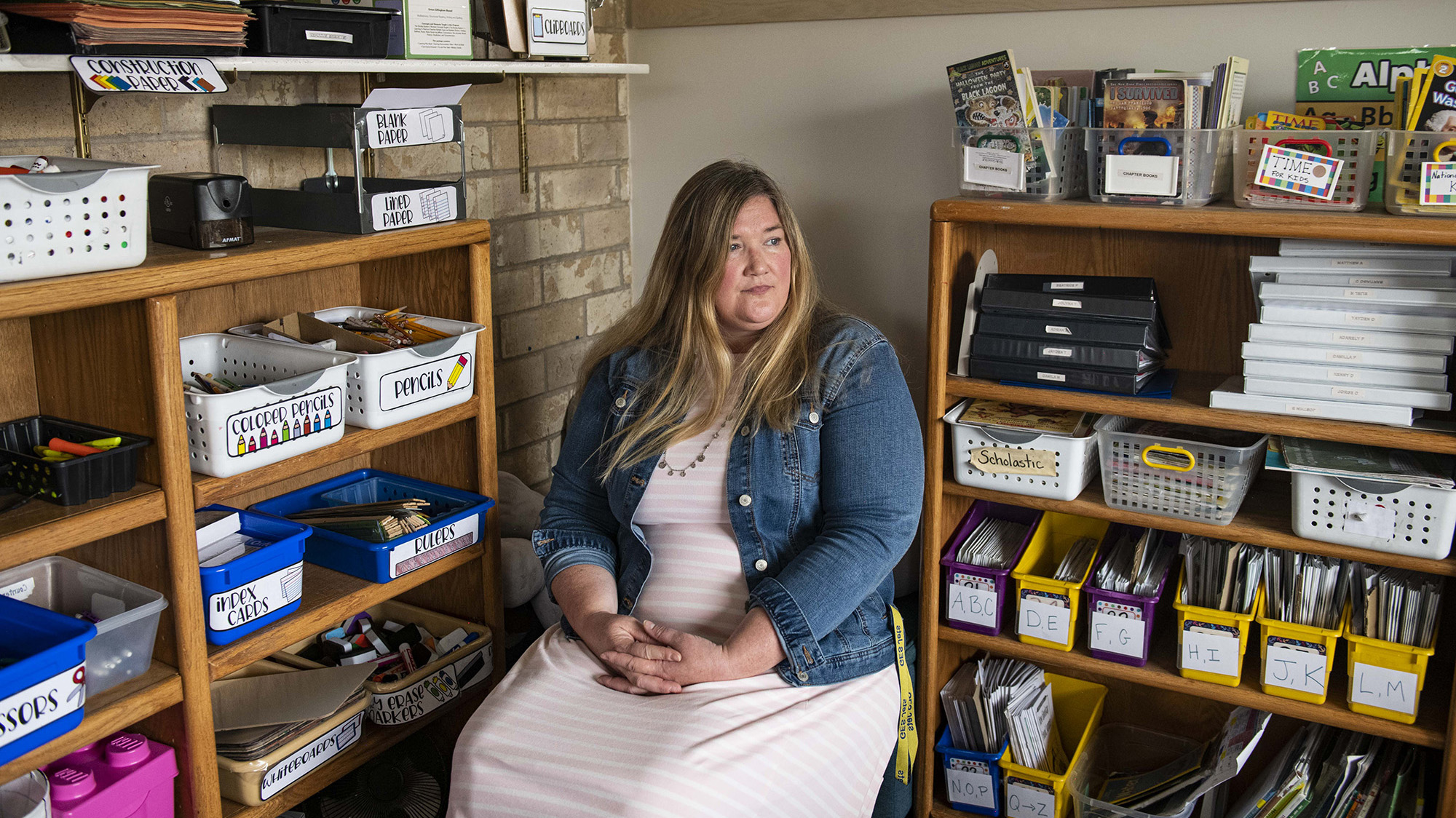This article was co-published with EdSurge. EdSurge is a nonprofit newsroom that covers education through original journalism and research. Sign up for their newsletters.
Carrie Rodgers gestures toward the silver medallion sitting atop her fridge, then waves it off.
It’s nothing really, she shrugs.
Still, she reaches for the disc and sets it on the kitchen counter for a closer look.
Two roofs and a pair of windows are etched into its center. Encircling the outline of those homes, the badge reads, “MAKE COLORADO AFFORDABLE 2022,” and below it, “IN GRATITUDE FOR YOUR LEADERSHIP.”
Rodgers hands it over, almost scoffing at the inscription.
Perhaps if things had gone differently for her, the token would register pride rather than bitterness. Instead, its presence in her home is like one of those trite souvenirs that says, “I went to the Bahamas and all I got was this lousy T-shirt.”
Rodgers, a teacher who works with disabled kids, had become outspoken about the housing crisis plaguing her community. She organized and fought for a statewide ballot measure to ease the housing burden on Colorado residents like her. She even rolled up her sleeves and helped build some of the low-cost homes being constructed for employees in her school district.
She entered a lottery—twice—for the chance to purchase one of those new units.
She tried, and she tried, and she tried.
And all she got was this lousy medallion.

Carrie Rogers’ Colorado Prop 123 badge alongside her teaching materials at her rental home in Eagle, Colorado.
Kelsey Brunner/EdSurge
Rodgers, 47, teaches in Eagle County School District. She moved to the area a decade ago from Baltimore, where she was burned out at work, navigating a breakup, and struggling to pay her bills.
She was in search of more balance in her life and hoped to find it in Eagle County, a rural mountain community where her sister lived, just over 100 miles west of Denver.
She got a job with the school district and took it, initially moving in with her sister until she could find a place of her own. But when it came to securing housing, she quickly found that “rural,” in this valley, is not synonymous with affordable, especially with two premier ski resorts—Vail and Beaver Creek—just a few miles down the road.
As she looked for a place to rent, Rodgers found that roommates were necessary and additional jobs non-negotiable. At first, and for a while, it was worth it, if only for the lifestyle—hiking, camping, kayaking, paddleboarding, and snowshoeing.
“I can literally walk out my door and go hiking for endless miles,” Rodgers says. That’s not hyperbole. She’s seen elk grazing just outside her window, which looks out onto aspen trees and snow-capped mountains in the distance.
In those ways, it is every bit the life Rodgers envisioned for herself when she made the decision to move here in 2013.
Yet the awe she experiences during the day is often shattered by sleepless nights, as she wonders and worries about how she’ll cover upcoming bills.
Rodgers has to supplement her $59,000 teaching income to cover her basics—a practice that has long been the reality for teachers in America. She waits tables at a restaurant and wine bar in town, teaches at an after-school program, coaches softball, and occasionally takes on babysitting and dog-sitting gigs.
“I don’t have the time to appreciate and enjoy the lifestyle,” she says. “I don’t have time to do laundry.”
Some months, even with her extra income, she still doesn’t have enough to cover rent. When things have gotten bad, Rodgers has sold household appliances like her television, pawned off prized possessions, and begged for odd jobs that would earn her quick cash.
In the last couple of years, Rodgers’ resolve has been worn down. She’s pushing 50 but juggling a handful of jobs. Her blonde hair is turning silver, yet she’s living with a roommate—as she has for much of her adult life. If she’s ever going to find the stability she craves, she figures she’ll need to buy a house, and she can’t do that here, where the median sales price for a home now exceeds $1 million.
“I’m done sacrificing,” Rodgers told me in May. “I love it here, but I don’t see a future.”
Housing has long been a barrier in the valley. Nearly half of properties are vacation homes that sit vacant for most of the year or operate as short-term rentals for visitors. The result is low inventory and high prices that create financial strain for the hourly workers who support tourism in the area, as well as the teachers, police officers, firefighters and nurses who make the region feel less like a hospitality engine and more like home to year-round residents.
Recently, as housing prices have continued to soar throughout the United States, that barrier has become insurmountable for many, with teachers and school staff moving out of the district at alarming rates, leaving students, families, and the staff who stay without their lifeblood, left to pick up the pieces and rebuild until another crop of employees decides next year that it is time for them, too, to move on.
Eagle County is a dramatic example of what many say is a national crisis. The evidence is everywhere. In Arizona, a school district is building tiny homes to house its teachers. In Texas, a district purchased a motel to rent out the rooms as staff housing. In California, district leaders have asked families to rent spare rooms in their homes to educators struggling to find a place to live.
Inflation has caused the price of basic goods and services to go up, and in no industry has that been more extreme than housing, for both buyers and renters. Meanwhile, teacher salaries have remained mostly stagnant (or where they’ve increased, it’s been insufficient to match the rising costs of meeting basic needs). What many communities are finding is that when affordable housing is scarce, so are teachers.
Last summer, the extent of the crisis in Eagle County was exposed when Philip Qualman, the district superintendent, circulated a letter to property owners here.
“At present, it’s nearly impossible to secure affordable housing in Eagle County,” Qualman wrote. “We offer jobs daily that are turned down because applicants can’t secure housing. The result is many vacant positions in ECSD and a school system stressed to capacity.”
Next came the superintendent’s plea to his community: “Open your home” to teachers and staff in our school district, he urged. “Vacant houses, condos, lock-offs, caretaker units, and empty bedrooms could all be put to use.”
The letter made national headlines. District leaders didn’t mind the coverage. In fact, they felt it was important for the issue to get a little sunlight, says Matthew Miano, the district’s chief communications officer.
“It got some media attention, but even better than that, we got 185 units,” Miano says, referring to the number of homeowners who, in response to the letter, agreed to list spare bedrooms, empty homes, and lofted garages for rent on a classifieds page visible only to the district’s 1,100 employees, 600 of whom are teachers.
“Now, I can’t speak to the affordability of those units,” Miano adds, trailing off.
Rodgers remembers reading that letter. So do all the other Eagle County school staff I interviewed. They are, after all, the very people the district is trying to retain. Few had heard of anyone who actually secured housing through one of those 185 units.
But all are keenly aware of the short supply of attainable housing in the valley. Edgar Arroyo, a long-time employee for the school district—first as a teacher, then as a Spanish translator—still shares an apartment with his ex-wife. The pair moved to Eagle County almost 20 years ago, when housing prices were far more reasonable. One-bedroom apartments in Eagle County today can go for the same price that his family of five pays for their three-bedroom unit. “I can’t move out,” says Arroyo, who sleeps in the living room. “I don’t have a choice.”
The arrangement wouldn’t be his first choice, but after what he’s seen, Arroyo counts himself among the fortunate few.
One of his colleagues became temporarily homeless after her landlord decided to sell the house her family had been renting, Arroyo shares. Another ended up living in a hotel room with her three kids for a full month because the owner of the mobile home where they lived had forced them to vacate it on short notice.
Low-wage families are arriving all the time with children who will enroll in the local public schools, Arroyo says. They come because they hear there is work in the valley, only to get here and find there is no housing. The same is happening to teachers being recruited from out-of-state and abroad to come work in Eagle County Schools.
“I think that’s the last thing on your mind, that you’re going to come here and encounter a lack of housing,” explains Arroyo, who recently accepted a new position at a charter school in the valley. “You think the hardest part is to get a job. In this county? There are plenty of jobs. The hardest part is to get housing.”
There’s a private Facebook group where people in Eagle County post about housing availability and needs. Some property owners in search of renters will specify, “Eagle County teachers only please,” or “Just for Eagle County Schools employees.”
That kind of concern for school staff is how Rodgers found the place she lived for the last five years. Her landlords, a couple whom she met dog sitting, were sympathetic to the challenges of teachers in the valley, where modest incomes are no match against the upward trend in housing costs. They always kept her rent low—$900 a month for the first three years and $1,100 for the last two—even though they could’ve gotten more from someone else.
Long-time residents recognize the way unaffordability is changing the community. It’s impossible to miss, says Elyse Howard, the parent of two children in the Eagle County school system and development director at Habitat for Humanity Vail Valley.
“Thank God my kids are older. They’re getting out of there,” says Howard, who has lived in Eagle County for over 20 years. Housing is “having such a big impact on teacher recruitment and teacher retention, an impact on who’s in front of our kids.”
People tend to want to own their homes, Howard explains, and if they live somewhere they can’t afford to do that, they typically want to move somewhere they can.
“It’s the American dream, right? To own a home,” she says. “In a resort community, it’s also about control and relieving stress.”
Howard says she and her colleagues hear stories of teachers moving “some ungodly number of times” or living on someone’s couch because their landlord decided to list their house on VRBO.
“If you own a home,” on the other hand, she says, “You have stability, you have equity, and you’re here for the long haul.”
But for a teacher in Eagle County today looking to buy their own place?
“There’s nothing,” Howard says flatly. “It’s not reasonable to think someone on a teacher’s salary could buy a $1.4 million home.”
Last year, 98 homes in Eagle County were sold for less than $500,000. That number has been dropping for at least the last decade: In 2012, 838 homes were sold in the county for under $500,000.
“Eagle County is losing the fabric of our community,” Howard says. “I moved here in 2000. It was expensive, but at that time, you could buy a house.” Now, she’s concerned about the future. “Who’s going to be here, teaching our kids?”
Last summer, the Keystone Policy Center, a Colorado-based nonprofit, released a report that helped some pieces click into place for Coloradans.
The report, Homeownership for Colorado Teachers: Affording the American Dream, examines whether teachers in the state can afford to purchase a home in the district where they work. Statewide, about one in five homes were found to be affordable on a teacher’s salary.
In Eagle County, where the average teacher salary is $58,000, only 6 percent of homes were considered affordable.
If that number sounds bleak, buckle up.
“It’s much worse than what we show,” says Van Schoales, a former teacher who now serves as the senior policy director at Keystone Policy Center and who co-authored the report.
That rate—6 percent—refers to assessed property values, not what’s available for purchase. He estimates that excruciatingly few properties go up for sale each year in Eagle County that are truly affordable to a teacher. I asked him for a number, his best guess.
“It’s probably two properties, if that,” he concedes. “And they might be trailers on leased lots.”
This, of course, is the reality that Rodgers has run into again and again.
She’s tired of living with roommates. She is also tired of worrying that her landlords will inform her that they’re actually going to need her to get out so their daughter can have the place after graduation. Or that they’re going to need her to get out because the market is hot and they’re planning to sell. Or that they’re going to need her to get out because they’ve calculated their earning potential, and they can make a killing if they list the unit on Airbnb or VRBO.

Carrie Rogers with her cat Sailor at her home for the past five years in Eagle, Colorado.
Kelsey Brunner/EdSurge
“There's always that lingering question, like what will happen if I have to move? Or what will happen if they do sell?” Rodgers explains. “I've been renting my entire adult life. I wanna put roots down.”
She’s considered everything, from buying and living in a camper van—she wouldn’t be the first teacher in Colorado to do it—to purchasing a mobile home. But even then, as Schoales notes, you own the trailer but lease the lot beneath it. It wouldn’t really be hers. It wouldn’t really be permanent.
“It’s not like having a house will solve all the problems,” Rodgers acknowledges. “But it’s stability. It’s security. It’s investing in myself.”
School communities all over the U.S. are experiencing the consequences of inflationary housing. It’s not quite universal, but it’s increasingly common.
Patricia Saenz-Armstrong, senior economist at the National Council on Teacher Quality (NCTQ), wanted to understand the relationship between the U.S. housing market and teacher staffing challenges today. She analyzed housing costs in 69 large metropolitan areas across all 50 states against teacher salaries at the largest school districts in those areas, then published her findings in a report in May.
In 15 of the metro areas analyzed, early-career teachers cannot afford to rent a one-bedroom apartment—it would cost more than 30 percent of their salary, which the US Department of Housing and Urban Development (HUD) considers the threshold for affordability, after which point other basic needs such as food and transportation become burdensome.
Saenz-Armstrong also wanted to know how long it would take a teacher to save for a down payment in those metro areas. The average American household can save for a 20 percent down payment on a house in about four years. By comparison, she found it would take the average single teacher 13.6 years to save for a down payment on a house.
In both analyses, teachers tend to be worse off financially when living in the coastal states—California, Oregon, Washington, New York, Virginia, Maryland—than in the interior of America.
Heather Peske, president of the NCTQ, says the relationship between housing costs and teacher turnover is clear: “When teachers can’t afford homes in their school district, it exacerbates teacher staffing challenges.”
It hurts recruitment, for one. Teachers who may otherwise be interested in a position at a school district in, say, the San Francisco Bay Area or Washington, DC, might be so deterred by rental costs that they accept a position elsewhere.
It also hurts retention. Teachers who can’t afford to buy a home in their district after 15 or 20 years, Saenz-Armstrong says, may move somewhere they can—whether it’s on the other side of the city, requiring a job at another school district, or in another part of the country.
This can set off a chain of events that ends up degrading the experiences of students, families, and the staff who remain, and in some cases, reconfiguring entire communities.
Peske elaborates.
“You lose your skill and capacity in a school when you keep bringing in new teachers who don’t have experience,” she says. “When teachers leave, [their] knowledge and skills and the investments districts have made go out the door. The district has to start again with a new crop of teachers.”
Think of all the hours of professional development districts invest in their teachers and staff each year, Peske says. “You’ve essentially wasted hours of time and lots of money in making sure that teacher knows how to implement the new curriculum. You have to keep rebuilding.”
In Eagle County School District, the turnover rate is nearly 20 percent annually. I asked Peske what that level of attrition does to a school.
“If you can imagine managing, as a principal, a team of people and rebuilding one-fifth of them every year, it becomes very difficult, in terms of the stability, the knowledge base, and ultimately the impact on students,” she says.
Rodgers has seen many colleagues in her elementary school come and go over the years. She can attest to the way that turnover detracts from lesson planning, curriculum development, and other precious time that is supposed to be built into a teacher’s day. “It’s very disruptive,” she says.
Teachers have been found to be the single most important in-school determinant of a student’s success. Yet when they leave, some students are more likely to suffer than others, according to decades of data: Students of color, English language learners, students from low-income families, and students with disabilities are more likely to be taught by inexperienced and less qualified educators.
“When you do that year after year after year to a group of kids who arguably need the best of our teacher force, it just means we’ll see the gaps in academic achievement. We’ll see increased discipline concerns, we could see increased dropout rates, and what we will not see is the academic recovery or the social-emotional recovery we need to see, given the devastating impacts of the pandemic,” Peske explains.
In some cases, housing prices can cause teachers who are unable or unwilling to leave their districts to shoulder long commutes to and from their schools. That’s what is happening to teachers and staff at Austin Independent School District in Texas, where a district survey earlier this year found that 27 percent commute over 30 minutes each way to work. In an open response section, many staff wrote that their commutes are over an hour—and some, over 90 minutes—each way.
This has its own negative consequences, says Jeremy Striffler, director of real estate for Austin ISD, which has been grappling with its own housing crisis as rental and purchase prices have become prohibitively high for educators in recent years.
“When your teachers and staff are living nearby, they're at the grocery store. You're gonna see them on the weekends, in the parks, at church, at stores,” Striffler explains, recalling his own experiences in school. “Over 50 percent of our population is economically disadvantaged. I think it's important that our teachers and staff are grounded in that reality and understand the challenges that the community faces. It's harder to understand that if you're commuting 45 minutes each way, living out in the suburbs and kind of disconnected from it.”
The survey was conducted to get a sense of the problem that district leaders already knew existed. But the responses, submitted by more than a quarter of the district’s 10,000 staff, revealed the level of urgency and severity of the challenge.
Almost three-quarters of teachers self-reported spending more than 30 percent of their salary on housing—meaning that 74 percent meet the HUD threshold for cost-burdened households. Nearly one-third of the staff said they spend more than 50 percent of their salary on housing, a rate that is considered severely cost-burdened.
In the comments, dozens of teachers—many of them regretfully—explain that they will have to leave the district or perhaps even the profession if something doesn’t change soon.
When housing prices are choking teachers out of their jobs and towns, it’s reasonable to assume that’s happening to workers in other professions too.
“The loss of housing affordability for teachers represents a canary in the coal mine for all of our communities,” says Peske.

Gypsum Elementary School in Gypsum, Colorado.
Kelsey Brunner/EdSurge
Howard, the parent in Eagle County, wonders if anyone would even want to live in a place that is unaffordable to the “critical community workforce” that upholds it.
“We all feel it’s so important that our teachers and school district staff can live here, coach here, participate in the school play—all the things you do when you’re part of a community,” Howard says. “What kind of community is that, where your teachers and firefighters and police officers can’t afford to live there, where they’re being outsourced? Don’t you want to run into them in the grocery store, or on the Fourth of July?”
An obvious solution here is to pay teachers more. Naturally, salary came up in every interview I conducted for this story. But it’s not that simple, or so leaders say.
In Austin, for example, a wonky state law known as “Recapture” effectively prevents the district from being able to pay its staff on par with its competitors in Houston and Dallas, which offer starting teacher salaries above $60,000 compared to Austin’s $52,000. In Eagle County, Miano says the district’s hands are tied on salaries due to Colorado’s “broken state funding model.” (Teachers and staff in both Austin ISD and Eagle County Schools will have higher starting salaries going into the 2023-24 school year.)
Schoales, of the Keystone Policy Center, notes that teacher salaries have increased considerably in Colorado in recent years. But so has the cost of housing—“and housing has gotten up faster.”
Saentz-Armstrong, the economist at the NCTQ, found the same to be true nationally, where teacher salaries have increased an average of 15 percent since 2017, but home rentals in her analysis have increased by 20 percent and purchase prices by a staggering 40 percent.
“Most states are not going to put enough money in the system for a teacher to afford to live in Palo Alto…or Telluride,” Schoales says. “It’s just not going to happen.”
Instead, many districts are trying another approach. They’re using district-owned land to develop affordable housing projects that can be rented or sold to staff.
Driving west on Interstate 70, past the exits for Vail, past signs for scenic overlooks and big-horned sheep, is a construction site where, in the coming months, 37 apartment units will become available for rent to Eagle County School District staff.
It’s one piece of a multi-pronged approach, outlined in ECSD’s 10-year housing plan, designed to guide the district through this acute crisis.
The two-story, motel-style complex, known as “Miller Flats,” sits just off the highway, across from soccer fields and adjacent to a high school, on district-owned land.
A secret weapon for many school districts is that they are often the largest landowners in their counties, with acres upon acres of undeveloped or underutilized space. In recent years, school districts in California, North Carolina, Missouri, Illinois and Colorado—including Eagle County—have been part of a growing trend to make use of that asset to house teachers.
The first building on the Miller Flats site is scheduled to be finished this fall, with another ready next spring. Tenants have been selected using a lottery system.
The complex will offer a mix of one-, two- and three-bedroom units, with rental rates based on the affordability threshold of first-year teacher salaries, which for the 2023-24 school year has a base of $50,500. A one-bedroom unit in the district-owned complex will rent for $1,260 a month, compared to the $2,000 or more a month Miano says he sees on listings posted to the district’s internal classifieds page and in Facebook groups.
The district is funding the project through Certificates of Participation (COPs), a financing model that made it possible for the district to take on no additional debt and local residents to absorb no tax hikes. When the units are occupied and renters begin making payments, they will be covering the cost of the project.
Another prong of the district’s housing strategy has already come to fruition. The district has partnered with Habitat for Humanity Vail Valley—the nonprofit organization where Howard works, which collaborates with locals to build affordable housing—on two projects.
The first project included the construction of a dozen houses on a site known as “Grace Avenue,” which is sandwiched between an elementary school and a middle school, near an open space where kids ride mountain bikes. Because the school district donated land for that development, Habitat agreed to earmark 12 homes for teachers and school staff— half at Grace Avenue and half in another neighborhood.

Grace Avenue Habitat, affordable housing in Gypsum, Colorado.
Kelsey Brunner/EdSurge

Grave Avenue Habitat is conveniently located between Red Hill Elementary School and Gypsum Creek Middle School.
Kelsey Brunner/EdSurge
Habitat broke ground on the second project, known as “Third Street,” in June. The organization will build 16 affordable houses on that site, three-quarters of which are reserved for district staff who earn up to 100 percent of the area median income. That’s about $82,000 a year for a single person and about $118,000 for a family of four.
Just 12 houses at Third Street were available for school district employees to purchase—out of a much larger pool of teachers and staff who had expressed a need.
To select among them, Habitat opted for a weighted lottery. Teachers would submit applications, and a computer would draw lots. Winners would get to buy homes sold at prices well below market rates and with zero-interest loans. In Eagle County, that’s akin to hitting the jackpot.
The Third Street project was, in Rodgers’ estimation, her last best hope for staying in the school district—and in Eagle County, for that matter. If she didn’t get it, she told herself, she would leave.
Everyone was rooting for her, some writing letters of support on her behalf—her sister who lives in Eagle County, a friend, the principal at her elementary school, her landlords, even her dentist.
She felt hope and desperation. After all, she had built sweat equity in the construction of homes for an earlier Habitat project, hammering nails, putting up walls, allowing herself to visualize what she’d do with this room or that if it were hers. And she had advocated on behalf of that statewide ballot initiative for affordable housing, which later passed.
That must count for something, she thought.
Rodgers submitted her application. So did 51 other school district employees. And then they waited.
In early May, her phone rang.
The computer did not spit out Rodgers’ name. She did not win the lottery. She would not get to own a home in Eagle County.
In an instant, the future she’d been holding out for crumbled around her. “Like a bubble burst,” she explains.
“The amount of times I've had to say to people, ‘Well, if I get this house, if I get this house, if I get this house'—and then having to work a third job again? And they called me and were like, ‘Oh, thank you so much for all your efforts. You tried so hard. We appreciate everything you were doing. You tried so hard.’”
Rodgers took it personally, she admits.
“They pretty much knew that if I wasn't gonna get this house that I'd be gone,” she told me in her living room in May, soon after learning that her application was not selected. “So in their minds, it’s like, ‘Oh, what's one more teacher?’”

Carrie Rogers, a teacher at Gypsum Elementary School, in her classroom.
Kelsey Brunner/EdSurge
Because the lottery is computerized, it’s truly a game of chance—albeit one that improves the odds for those who are determined to have greater need. But the entire applicant pool was full of educators like Rodgers with ultimatums.
“Of all the applications, every single person was like, ‘If I don’t get this, I’m leaving,’” recalls Howard. “They’ve all had it.”
Howard says some of the teachers and school staff who did win the lottery for Third Street—a special education teacher who’s been in the district a while, a high school math teacher who coaches cross-country, a high school social studies teacher—also expressed that this was their last best hope.
For every homeownership opportunity Habitat creates in Eagle County, there are approximately 10 applicants. The forthcoming rental complex will help with affordability, but even the district’s 10-year housing plan estimates it will only support about 13 percent of staff with all the projects underway and still ahead.
“They’re making these efforts,” Rodgers says, “but it’s still just not quite enough.”
A school district is not a housing developer. Could Eagle County School District be doing more? Miano rejects the idea.
“It would be crazy for us to think we could cure the housing woes,” he says, noting that other industries throughout the valley, from the hospitals to the ski resorts, are grappling with these same questions.
“Every step made is incrementally toward the end goal, but the end goal may not be attainable.”
He may be right. When school districts are getting into the housing development game, it’s worth stopping to ask how we got here, suggests Peske of the National Council on Teacher Quality.
She insists that it is not school districts’ responsibility to “solve the affordable housing crisis.”
Yet it is district leaders’ responsibility to maintain an effective educator workforce, and right now, many can’t do that without addressing housing.
“Many districts have been inventive out of necessity,” Peske says, explaining that these workforce housing projects are just another effort to get—and keep—teachers.
Once the dust settled on the outcome of the Third Street project, Rodgers decided to stay in Eagle County—for this year, at least.
The housing market is not on her side right now, she figures—in Colorado or on the East Coast, where she’s considered returning. Plus, her teacher’s union negotiated a new contract, and she’s getting a nearly 10 percent raise.
Her uncertainty this past spring about her future plans meant that she lost the opportunity to renew her lease in the small guest house where she’d been living for five years.
She found yet another place to live, with yet another roommate—a pastry chef—and landlords who are “deliberately keeping their costs lower to keep housing affordable.” They actually listed their place for rent, Rodgers says, after receiving the superintendent’s letter last year.
In July, she told me that she’ll reevaluate her plans—yet again—in a few months.
She’s sure, though, that she still wants to own a home.
“I needed to grasp,” she said, “that maybe it’s not the best timing for my dream right now.”
















